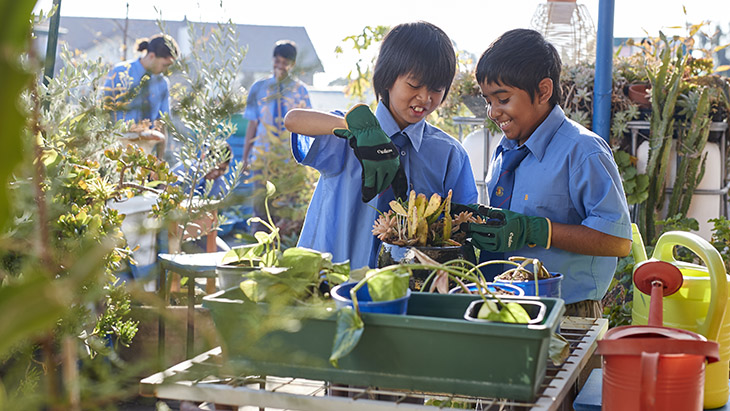Sandeep's story

1. What are Sandeep's strengths and what has been helpful so far?
Sandeep's strengths:
- Sandeep is well-liked by his peers.
- Sandeep is verbal and social.
- Sandeep has a supportive family network.
- Sandeep has access to a speech pathologist and enjoys working with them.
- Sandeep likes to sing and dance.
What has been helpful:
- Sandeep works well with one-to-one support.
- Sandeep responds well to visual cues.
- Sandeep is more motivated when a task/outcome has links to a personal interest.
- Sandeep works well when paired with one or two peers of the same ability.
- Small steps/tasks have been helpful when learning a new skill.
What has not been helpful:
- Noise levels can disrupt Sandeep’s concentration.
- Sandeep is less likely to stay on-task in large groups.
- Presenting Sandeep with a challenging task, that Sandeep may find overwhelming.
2. What is the goal and why is it important?
The goal:
Sandeep’s initial goal is to write two sentences with the focus being on getting the idea down, not on the spelling or grammar. The overall goal is for Sandeep to write two sentences with correct punctuation and grammar by the end of the term.
These goals may be developed into growth goals as part of the collaborative curriculum planning process and included in Sandeep’s Personalised Learning and Support Plan.
Why:
Literacy skills, including written expression, can help students to express their thoughts or responses when communicating. Writing supports fine motor skill development which will support Sandeep in other areas of his education, and in his future autonomy and independence.
Personalised learning and support will ensure Sandeep enjoys a rigorous and meaningful education.
3. What evidence-based strategies can be used to reach the goal?
Strengths
Sandeep is more motivated when a task/outcome has links to a personal interest.
Sandeep likes to dance and sing.
Strategy
Where feasible, Sandeep will be encouraged to incorporate his interests into his writing.
Sandeep will spend 10 minutes three times per week completing short and simple online activities that use songs/dance to reinforce sentence structure.
__________________________________________________________________________________________________________________________
Sandeep works well with one-to-one support.
Sandeep is verbal and social.
Sandeep is well-liked by peers.
Sandeep works well when paired with one or two peers of the same ability.
One-to-one support with writing will be offered three days per week.
Sandeep’s teacher will get his attention through making eye contact, using his name and using gestures.
Sandeep will be paired with 1-2 peers of the same ability.
__________________________________________________________________________________________________________________________
Small steps/tasks have been helpful when learning a new skill.
Sandeep responds well to visual cues.
Most-to-least prompts will be provided initially (for example; “Sandeep, if your sentence is The man stole his mp3 player. Then you need to write the first word, which is The”), and as Sandeep becomes more proficient these prompts will gradually shift to least-to-most (for example; “Sandeep, what was the first word in your sentence?”)
To manage the demands that these tasks can place on Sandeep’s attention, enjoyable activities or breaks will be introduced at the beginning and end of writing tasks.
All writing tasks set will incorporate some skills that Sandeep has already mastered.
Visual support (such as cue cards) will be used to help Sandeep stay on-task.
A range of materials (for example; paper, chalk on pavement, keyboards, whiteboard, etc.) will be used across tasks.
__________________________________________________________________________________________________________________________
Sandeep has a supportive family network.
Sandeep has access to a speech pathologist and enjoys working with them.
Sandeep’s teacher will regularly communicate with Sandeep’s family and the speech pathologist to develop a shared understanding of what they are working on.
__________________________________________________________________________________________________________________________
School Excellence Framework alignment
Wellbeing, Effective classroom practice
Australian Professional Standards for Teachers alignment
Standard 1: Know students and how they learn
Audience
Primary teachers, SLSOs
Purpose
This resource explores Sandeep's experience in the classroom. Sandeep is a primary student who is on the autism spectrum. The example of practice features some of the strategies that have support Sandeep at school.
Reviewed
November 2021. Share your feedback here
Explore other topics
1/4